#quantized spacetime
Explore tagged Tumblr posts
Text
sustainability-times.com
A #unifiedfieldtheory "that encapsulates both #generalrelativity & #quantummechanics remains one of the most compelling challenges in modern #physics. The idea of #quantizedspacetime is a critical step in this journey"
#Planckpower
https://www.sustainability-times.com/research/einstein-would-lose-his-mind-scientists-uncover-ultimate-power-limit-that-could-finally-fuse-relativity-with-quantum-mechanics/
0 notes
Note
Oh speeches alright ihm. Well I guess I’m the silly anon here cuz I literally pick things up off the streets of new jersey and gives them to ford. And it ends up useful sometimes. So. I’d say that’s pretty silly. Plus I’m literally a temmie.
Well I don’t have much so take an essay on General Relativity and Quantum Mechanics
Einstein's theory of General Relativity is a physical theory describing space and time, to keep it simple. However, this theory is clashed by Quantum Mechanics, which explains how extremely small objects share the characteristics of both particles and waves, also called “wave-particle duality”. So, what are these theories precisely, and why do they clash?
According to Elena Giorgi, an assistant professor at Columbia University, “General relativity is a physical theory about space and time and it has a beautiful mathematical description. According to general relativity, the spacetime is a 4-dimensional object that has to obey an equation, called the Einstein equation, which explains how the matter curves the spacetime.” More simply, general relativity explains that spacetime is 4 dimensional and follows Einstein’s equation, E=mc^2. This equation, meaning that energy equals mass times the speed of light squared, claims that mass and energy are the same thing, and that is how matter curves the spacetime. Spacetime is how the three dimensions of space fuse with the one dimension of time to fit into a four dimensional continuum. So general relativity is how E=mc^2 curves spacetime. This theory was established in 1915, since then has been proven many times, the common way being the perihelion precession of Mercury’s orbit.
General relativity is a strong and proven theory, however, it does have a fault that quantum mechanics exploits. Quantum mechanics, as I said earlier, explains how extremely small objects have characteristics of waves and particles, also known as wave-particle duality. They sound like entirely different theories explaining different things, and while that isn’t wrong, quantum mechanics still breaks it. While general relativity has passed all experiments, it is applicably expected to break down when quantum mechanics should become dominant. Whether this would happen is difficult. The two theories are mathematically incompatible, so whether to quantized spacetime or to modify the quantum theory is unclear, especially with a newer theory developed by UCL physicist Professor Johnathan Oppenhiem and his PhD students that suggests spacetime isn’t governed by quantum mechanics at all. The main issue is that if one is true, the other doesn’t exist at all, so two strong and well proven theories cannot coexist.
Going for the nerd vote! Kinda smart!
What an exhilarating read.
11 notes
·
View notes
Text
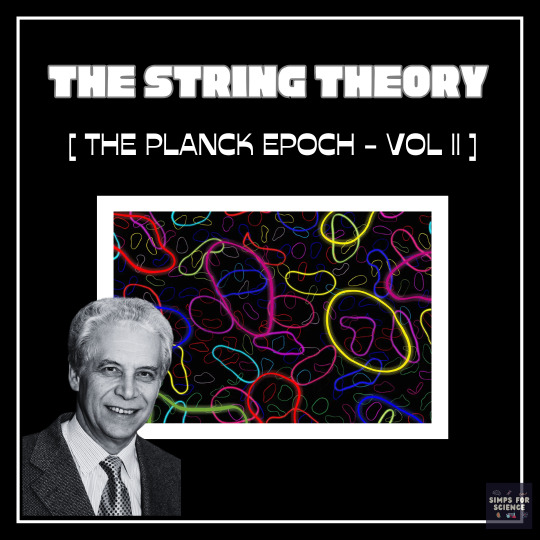
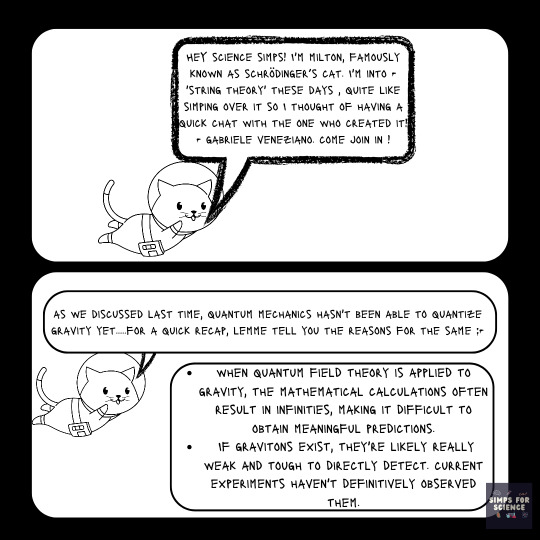
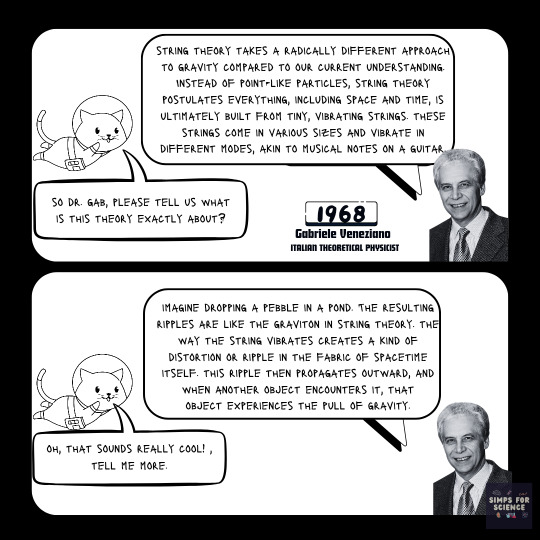
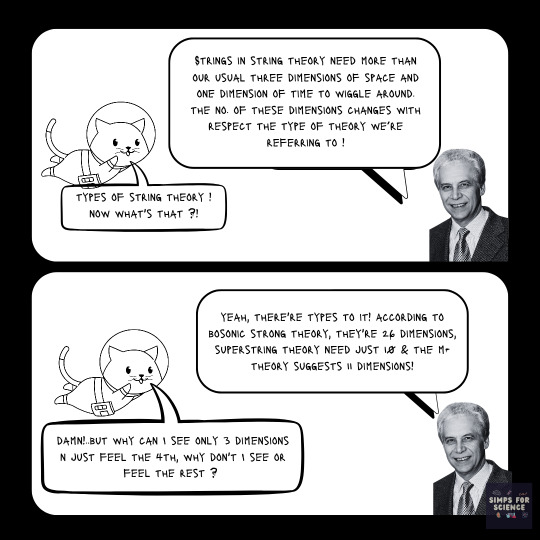
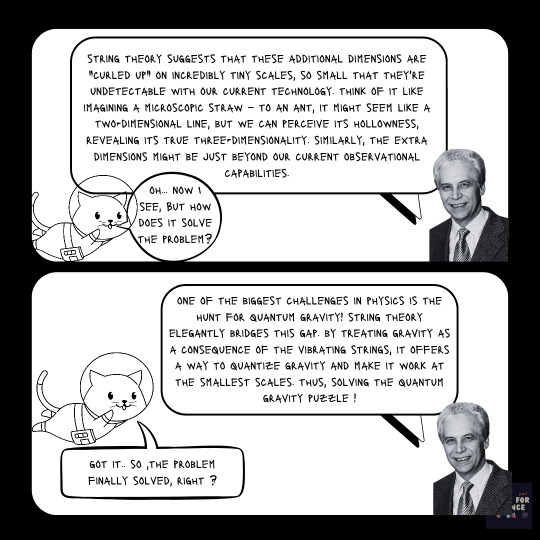
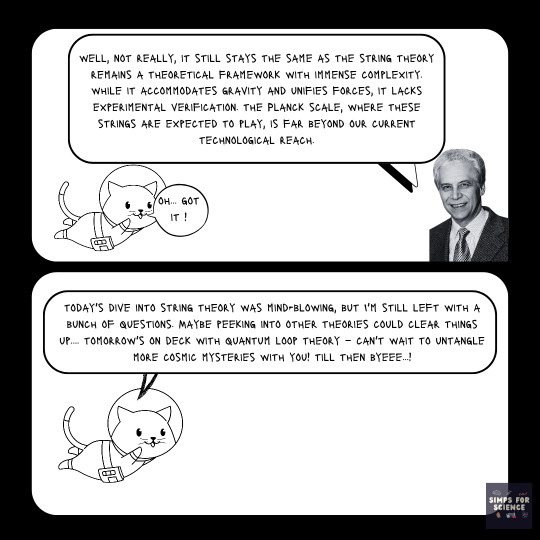
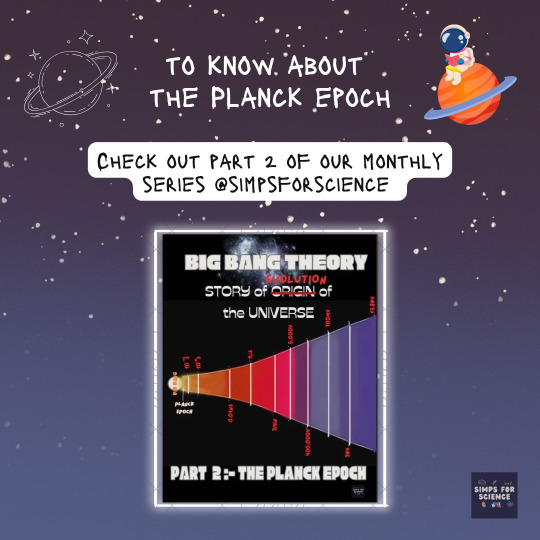
Imagine a universe 💭🌠 where gravity is a consequence of tiny strings dancing in the fabric of spacetime. 😮 That's the audacious proposal of String Theory's approach to quantization. Swipe ➡️ through this post to dig deeper 🔍 into it. Is this the future of physics? 🔭⚛️ Tell us your opinions down below in the comments!
📸 Image Credits :-
Gabriele Veneziano : Victor de Schwanberg/Alamy
Strings of String Theory: Abhinav P.Pradeep / blogspot
#string theory#planckepoch#bigbangtheory#theoreticalphysics#physics#physicist#astrophysics#cosmology#cosmos#astronomy#space#galaxy#discover#quantum physics#science memes#science#explore#scicomm#education#comic art#comics#study blog#science facts#physics comic#cool science#simps for science
24 notes
·
View notes
Text
Not Even Wrong: The Case Against String Theory
Peter Woit is a mathematician and physicist known for his work in quantum field theory and quantum gravity. He is a senior lecturer at Columbia University, where he has been involved in teaching and research for many years. His academic interests lie in the mathematical underpinnings of theoretical physics, particularly in understanding the fundamental forces and particles that make up the universe.
Woit is perhaps best known for his critical stance on string theory, a prominent theoretical framework that attempts to reconcile quantum mechanics with general relativity by proposing that the fundamental constituents of the universe are one-dimensional "strings" rather than point particles. Despite its popularity, string theory has faced criticism for several reasons. One of Woit's primary criticisms is that string theory has not produced any testable predictions that can be verified through experiments. This lack of empirical evidence makes it difficult to validate or falsify the theory. Additionally, Woit argues that string theory has led to a proliferation of possible solutions, known as the "landscape problem," where an enormous number of possible universes exist within the theory's framework. This makes it challenging to identify which, if any, correspond to our observed universe. Furthermore, Woit has expressed concern that the dominance of string theory has stifled alternative approaches to understanding fundamental physics, such as twistor theory and loop quantum gravity. Twistor theory, originally proposed by Roger Penrose, offers a mathematical framework that could potentially unify general relativity and quantum mechanics. Loop quantum gravity is another approach to quantum gravity that attempts to quantize spacetime itself without relying on strings.
The detailed critique of string theory in his book "Not Even Wrong" explores the history and development of theoretical physics. The title refers to a phrase attributed to physicist Wolfgang Pauli, describing theories that are so flawed they cannot even be considered incorrect. Woit argues that string theory fits this description due to its lack of testable predictions. He believes that fostering a diverse range of ideas and approaches is essential for advancing our understanding of fundamental physics and he hopes to inspire future breakthroughs in areas like quantum gravity and particle physics by encouraging open-mindedness and innovation.
Peter Woit: String Theory and the Crisis in Physics (Robinson Erhardt, September 2024)
youtube
Saturday, September 21, 2024
4 notes
·
View notes
Text
Why Time Is a Mystery in Physics
The Interwoven Fabric of Spacetime: Einstein's Insights
At first glance, time appears straightforward—a linear progression from past to present to future. However, delving into the intricate tapestry of modern physics, we uncover a perplexing mystery surrounding time's fundamental nature. This enigma is intricately entwined with the relationship between time, space, and gravity—a relationship that Albert Einstein's revolutionary theories illuminated.
Einstein's theory of relativity transformed our understanding of the universe. Central to this theory is the concept of spacetime, an intertwined four-dimensional continuum where time and space are inextricable. In this framework, gravity is not a force in the traditional sense; rather, it's the curvature of spacetime caused by massive objects. As objects move through this curved spacetime, their paths are altered—a phenomenon beautifully demonstrated by the bending of light around massive celestial bodies.
This curvature of spacetime, in turn, influences the passage of time. It leads to a remarkable phenomenon known as time dilation, a concept that defies our everyday intuitions. When an object is subjected to intense gravitational fields or high speeds, time for that object moves slower relative to an observer in a different frame of reference. This has practical implications, as evidenced by the accuracy of the Global Positioning System (GPS), which corrects for the dilation effect to maintain precise time measurements.
Quantum Conundrums: The Mysteries Deepen
Venturing into the realm of quantum mechanics, the mysteries surrounding time take on a new dimension. Quantum mechanics, the framework governing the behavior of particles on the tiniest scales, introduces complexities that challenge our conventional understanding of time. A perplexing feature is the role of time in the collapse of the quantum wave function.
Illustrated vividly by Schrödinger's cat—a theoretical experiment involving a cat in a superposition of life and death—this concept exemplifies the uncertainty and peculiar behavior of quantum states. The question of when and how these states collapse upon observation raises profound questions about time's role in these quantum events. Does time play a definitive role in this process, or is it merely a bystander to the unfolding quantum drama?
Unifying the Fundamental Forces: The Quest for a Theory of Everything
One of the grand ambitions of theoretical physics is the unification of the fundamental forces—gravity, electromagnetism, and the strong and weak nuclear forces—into a coherent framework. String theory and loop quantum gravity are two prominent contenders in this pursuit, each offering unique insights into the nature of time and the fabric of reality.
String theory posits that the fundamental building blocks of the universe are not point-like particles but rather tiny, vibrating strings. These strings dance and vibrate in intricate patterns, giving rise to the diverse particles we observe. Moreover, string theory suggests that gravity itself can be understood within the quantum framework, potentially reconciling general relativity with quantum mechanics.
Loop quantum gravity, on the other hand, proposes that spacetime itself is quantized—composed of discrete, granular elements. This approach attempts to marry the principles of quantum mechanics with the fabric of spacetime, presenting an alternative to the continuous spacetime of general relativity.
The Enigma Persists: Philosophical Implications
Amidst these profound theoretical strides, the enigma of time's nature persists. Some theories speculate that time, as we perceive it, might emerge from a deeper, timeless reality at the quantum scale. Others ponder whether time's arrow—the directionality from past to future—is a consequence of initial conditions and entropy.
As humanity's quest for understanding propels us further into the cosmos and deeper into the quantum realm, the nature of time remains a captivating puzzle. Its connection to the fabric of reality, its potential relationship with consciousness, and its role in the unfolding story of existence continue to spark curiosity and inspire exploration.
In Conclusion: Unraveling the Temporal Tapestry
The mystery of time in physics stands as a testament to the intricate interplay of our universe's fundamental aspects. Einstein's revelations about spacetime and time dilation, combined with the quantum enigmas of wave function collapse, have set the stage for our exploration. As string theory and loop quantum gravity strive to weave the threads of spacetime and forces into a unified fabric, the nature of time's essence remains shrouded in uncertainty.
In our unyielding pursuit of knowledge, we unravel the temporal tapestry thread by thread, inching closer to comprehending the very essence of existence itself.
Courtesy: https://useglobaleducation.com.
#TimeMystery#SpacetimeEinstein#QuantumConundrums#UnifyingForces#StringTheory#LoopQuantumGravity#NatureOfTime#TemporalPhilosophy#CosmicExploration#QuantumFrontiers#PhysicsEnigma#TimeDilation#SchrödingersCat#QuantumReality#MysteriesOfExistence#UnravelingTime#FundamentalPhysics#EinsteinLegacy#TemporalUniverse#QuestForUnderstanding
2 notes
·
View notes
Text
1. Computational dramaturgy language.
To gain a deeper understanding of the nature of quantum dramaturgy, it is crucial to familiarize oneself with several key concepts that serve as the foundation of contemporary science accepted within the scientific community. These concepts form the building blocks of our understanding.
Planck's constant.
Planck's constant is a fundamental constant that plays a vital role in quantum mechanics. It quantifies the energy carried by individual particles and establishes the scale for the granularity of the quantum world. Dramaturgy adheres to quantum laws just as rigorously as any other fundamental study. Although Planck's constant is not directly observed, its theoretical implications are integrated into our everyday lives. Dramaturgy unfolds in Planck's steps.
Speed of light constant.
The speed of light in a vacuum is a universal constant that serves as an absolute limit on the speed at which information or fermions can travel. Planck's time and the speed of light are constants and limitations that unite us as observers within the quantum realm. Understanding, researching, and conquering this realm is a formidable task that is best approached through dramaturgy. The speed of light is an essential component of Einstein's theory of relativity, quantum mechanics, and computational dramaturgy. Just like any other form of information in this world, dramaturgy is quantized and propagates at the maximum speed of light.
The concept of entangled particles, which can seemingly “teleport” information faster than light, instantly across any distance, will be separately discussed further, as it constitutes a fundamental property of dramaturgy.
Atom of space.
The concept of the atom of space, introduced by Steven Wolfram and his computational physics, pertains to the fundamental building blocks of the fabric of spacetime. In the context of quantum dramaturgy, the atom of space represents the smallest indivisible unit of space, possessing unique properties and interactions, primarily of a dramaturgical nature. It’s true because if you didn’t care and nothing literary cared about something else on fundamental quantum level, no interactions or perception of those interactions would occur. No dramaturgy – no anything.
Multidimensional perception.
Computational Dramaturgy invites us to expand our understanding beyond the limitations of our familiar four-dimensional perception (3D space + time). It suggests the existence of additional dimensions that may profoundly influence and shape our reality. Dramaturgy provides us with an effective and mathematical means to experience these dimensions and comprehend their impact on our lives, even without a complete understanding of their other properties, except for the fact that they differ from the dimensions we are familiar with. While the exact nature of these dimensions remains elusive, we can perceive and classify their influence on observable reality. The relentless drive of evolution, the power of the sun, heat, and the captivating force of dramaturgy are truly awe-inspiring.
Out-of-the-box perspective on entities.
Computational dramaturgy challenges conventional perspectives on entities such as corporations, fan clubs, popular songs, money, or patriotism. It encourages us to explore their dynamic nature, their influence on our collective drama, and their interplay. Why is it that when examined individually, everyone appears to be a "good" person, yet on a larger scale, wars, pain, and suffering persist? Where does this stem from? Is there something higher than humans that makes real decisions? Dramaturgy holds the key, offering glimpses of multidimensional intrusion into our familiar four-dimensional understanding. It has personal motives and roles, it has tools in this world and it act right now.
Thus, most people believe there exists something greater than us, but its nature is bizarre and can only be examined and processed by our brains through the lens of computational dramaturgy.
Perception of time as entropy.
Quantum dramaturgy invites us to reconsider our perception of time as a linear progression. It explores the realms of non-linearity and multidimensionality, where the boundaries between past, present, and future become blurred.
In the realm of computational dramaturgy, all that is required is Planck's Time, the speed of light, and the concept of entropy. Entropy serves as one of the most undeniable pieces of evidence of dramaturgy's existence in our reality, as it is a fundamental law intimately intertwined with the flow of time forward. Time predominantly moves in one direction, driven by entropy. Other formulas and laws can generally be reversible, remaining similar whether played forward or backward, but entropy represents the unfolding of the future.
Therefore, entropy (and the sense of time it creates) forms the basic foundation of our universal Turing machine, the computational universe. It establishes the reality's forward unfolding, processing an increasing number of entropy options, either accelerating or decelerating the flow of time.
Entropy allows us to surf the wave of "now," creating advantages, just as a conscious surfer rides a naturally occurring computational wave. However, the surfer cannot alter the amplitude of the waves, halt or create new waves. Their sole ability is to surf.
Hence, within the forthcoming pages, we challenge you to cast aside the conventional notion of time as we commonly perceive it and instead embrace the logic of quantum dramaturgy, where time operates in accordance with the principles of the quantum world itself. You will find out how your personal “timeless” dramaturgic potential can affect past & future.
1.7 Shift of human nature.
As we get into quantum dramaturgy, we confront the idea that human beings are not confined solely to the four-dimensional realm of space and time. Instead, we propose that humans transcend these limitations and exist at least as tentacles or eyes of higher entities that penetrate our reality, navigating and influencing dramaturgy across multiple dimensions, including the past and the future.
To establish a foundational understanding of these concepts and their fundamental connection to dramaturgy, let's examine them more closely.
#dramaturgy#computationalcreativity#quantum physics#innovation#dramaturgical potential#quantum dramaturgy#physics of important things#science#philosophy#psychology#psychic#psychonauts#fate#god#soul#wolfram#Donald Hoffman#game theory#weird#bizarre#creepy#odd#weird stuff#strange new worlds#life is strange
1 note
·
View note
Text
Quantum time






QUANTA OF TIME
At home, there is an old jug of wine, nine years gone by. There is, Fillide, in the garden, parsley to weave into garlands and plenty of ivy… I invite you to celebrate this mid-April day, a day of celebration for me, almost dearer than my birthday. (IV, 11)
The strange landscape of relativistic physics I have described so far becomes even more alien when we consider quanta: the quantum properties of space and time.
The discipline that studies them is called "quantum gravity," and it is my field of research. There is not yet a theory of quantum gravity that has gained the consensus of the scientific community and has been confirmed by experiments. My scientific life has been largely dedicated to contributing to the construction of a possible solution to this problem: loop quantum gravity, or the theory of loops. Not everyone bets on this solution. My friends working on string theory, for instance, follow different paths, and the debate over who is right is in full swing. Well, science also grows through fierce discussions: sooner or later, we will clarify who is right, and perhaps we are not far from that moment.
Regarding the nature of time, however, in recent years, divergences have diminished, and many conclusions have become quite clear to most. What has become evident is that even the remaining temporal framework of general relativity, illustrated in the previous chapter, disappears when we take quanta into account.
Universal time has shattered into a myriad of proper times, but if we consider quanta, we must accept the idea that each of these times, in turn, "fluctuates," is scattered like a cloud, and can only take certain values, not others. They no longer come together to form the spacetime sheet drawn in previous chapters.
There are three fundamental discoveries that quantum mechanics has led to: granularity, indeterminacy, and the relational aspect of physical variables. Each of these further demolishes what little remained of our idea of time. Let’s examine them one by one.
Granularity
The time measured by a clock is "quantized," meaning it takes only certain values and not others. It is as if time were granular rather than continuous.
Granularity is the characteristic consequence of quantum mechanics, from which the theory itself gets its name: "quanta" are the elementary grains. There is a minimum scale for all phenomena. For the gravitational field, this is called the "Planck scale." The minimum time is called "Planck time." Its value is easily estimated by combining the constants that characterize relativistic, gravitational, and quantum phenomena. Together, these determine the time of 10⁻⁴⁴ seconds—a hundred millionth of a billionth of a billionth of a billionth of a second. This is Planck time: at these incredibly small scales, quantum effects on time manifest.
Planck time is tiny, much smaller than what any real clock can measure today. It is so small that it is not surprising that "down there," at such a minuscule scale, the notion of time ceases to hold. Why should it still apply? Nothing remains valid everywhere and forever. Sooner or later, we always encounter something entirely new.
The "quantization" of time implies that almost all values of time t do not exist. If we could measure the duration of an interval with the most precise clock imaginable, we would find that the measured time takes only certain discrete special values. We cannot think of duration as continuous. We must think of it as discontinuous: not as something that can flow uniformly, but as something that, in a sense, jumps, like a kangaroo, from one value to another.
In other words, there is a minimum interval of time. Below this, the notion of time does not exist, even in its barest sense.
Rivers of ink have been spilled over the centuries, from Aristotle to Heidegger, to discuss the nature of the "continuum"—perhaps in vain. Continuity is merely a mathematical technique to approximate things that are very finely grained. The world is subtly discrete, not continuous. The Good Lord did not draw the world with continuous lines: He dotted it lightly with His hand, like Seurat.
Granularity is ubiquitous in nature: light is made of photons, particles of light. The energy of electrons in atoms can take only certain values and not others. The purest air and the most compact matter are granular: they are made of molecules. Once we understand that Newton’s space and time are physical entities like everything else, it is natural to expect them to be granular as well. Theory confirms this idea: loop quantum gravity predicts that elementary temporal jumps are small but finite.
The idea that time might be granular, that there are minimum time intervals, is not new. It was defended in the 7th century AD by Isidore of Seville in his Etymologiae, and in the following century by The Venerable Bede in a work significantly titled De Divisionibus Temporum (The Divisions of Time). In the 12th century, the great philosopher Maimonides wrote: "Time is composed of atoms, that is, of many parts that cannot be further divided, due to their short duration." The idea is probably even older: the loss of Democritus’s original texts does not allow us to know whether it was already present in classical Greek atomism. Abstract thought can anticipate hypotheses by centuries before they find use—or confirmation—in scientific investigation.
The spatial counterpart of Planck time is the Planck length: the minimum limit below which the notion of length loses meaning. The Planck length is about 10⁻³³ centimeters—a millionth of a billionth of a billionth of a billionth of a millimeter.
As a young student at university, I became fascinated by the problem of what happens at these minuscule scales; I painted a large sheet with the number 10⁻³³ glowing in red at its center.
I hung it in my bedroom in Bologna and decided that my goal would be to try to understand what happens down there, at the tiniest scales where space and time cease to be what they are. Down to the fundamental quanta of space and time. Then I spent the rest of my life trying.
Quantum Superpositions of Times
The second discovery of quantum mechanics is indeterminacy: it is impossible to precisely predict, for example, where an electron will appear tomorrow. Between one appearance and the next, the electron does not have a definite position; it is as if it were spread out in a cloud of probability. In the jargon of physicists, it is said to be in a "superposition" of positions.
Spacetime is a physical entity, just like an electron. It also fluctuates. It too can be in a "superposition" of different configurations. The depiction of time stretching, for instance, must—if we take quantum mechanics into account—be imagined as a blurred superposition of different spacetimes, much like in the image below.
Similarly, the structure of light cones fluctuates in each point, distinguishing past, present, and future, as shown here:
Even the distinction between present, past, and future therefore becomes fluctuating and indeterminate. Just as a particle can be spread out in space, so too can the difference between past and future fluctuate: an event can be both before and after another.
Relations
"Fluctuation" does not mean that what happens is never determined; it means that it is determined only at certain moments and in an unpredictable manner. Indeterminacy is resolved when a quantity interacts with something else.
When interacting, an electron materializes at a precise point. For example, it hits a screen, is captured by a particle detector, or collides with a photon; it takes on a concrete position.
But there is something strange about this concretization of the electron: the electron is concrete only with respect to the physical objects with which it is interacting. Relative to all others, the interaction merely spreads the contagion of indeterminacy. Concreteness exists only relative to a physical system; this, I believe, is the radical discovery of quantum mechanics.
When an electron hits an object—such as the screen of an old cathode-ray tube television—the probability cloud in which we imagined it "collapses," and the electron materializes at a specific point on the screen, producing the bright dot that contributes to forming the television image. But this happens only relative to the screen. Relative to another object, the electron simply transfers its indeterminacy to the screen, so that electron and screen together exist in a superposition of configurations. Only when they interact with yet another object does their shared probability cloud "collapse," concretizing into a particular configuration, and so on.
It is difficult to grasp the idea that an electron behaves in such a bizarre way. Even harder is to accept that space and time behave the same way. Yet, quite evidently, this is the quantum world—the world we live in.
The physical substrate that determines durations and time intervals—the gravitational field—not only has a dynamics influenced by masses; it is also a quantum entity that lacks definite values except when interacting with something. When it does, durations become granular and are determined only for that specific interaction, while remaining indeterminate for the rest of the universe.
Time has dissolved into a network of relationships that no longer even weave a coherent fabric. The images of fluctuating, overlapping spacetimes, concretizing or retreating relative to particular objects, form a vague vision—but it is the best we have left of the fine structure of the world. We are beginning to glimpse the world of quantum gravity.
Let me summarize the long plunge downward that this first part of the book has been. Time is not unique: there is a different duration for each trajectory; it passes at different rates depending on location and velocity. It is not oriented: the difference between past and future does not appear in the fundamental equations of the world; it is a contingent aspect that emerges when we observe things while ignoring details. In this blurring, the past of the universe was in a curiously "peculiar" state. The notion of "present" does not hold: in the vast universe, there is nothing we can reasonably call "the present." The substrate that determines the durations of time is not an independent entity distinct from the others that make up the world; it is an aspect of a dynamic field. This field jumps, fluctuates, and only concretizes through interaction; it is undefined below a minimal scale… So what remains of time?
"You'd better throw away the watch on your wrist and try to understand that the time it seeks to capture is nothing more than the movement of its hands..."
We are entering a world without time.
source: Rovelli Carlo, L'ordine del tempo
0 notes
Text
My conflict theory
Please forgive the preamble on physics. First, the three-body problem in classical mechanics. Herein, one might focus on the motion of bodies under the influence of forces, including mass and energy interactions in macroscopic systems. This entails Newton's laws, momentum, energy conservation, and mechanical equilibrium. Also, in thermodynamics and statistical mechanics, one might explore the relationship between heat, or energy, work, and the physical properties of systems at both macroscopic and microscopic levels. These then entail energy transfer, entropy, phase transitions, and the statistical behavior of particles.
Additionally, there's electromagnetism, the study of electric and magnetic fields and their interaction with matter, which involves forces, energy transfer, and the motion of charged particles.
One mustn't omit Maxwell's equations, electromagnetic waves, and energy in electromagnetic fields, either, nor relativity, which is relevant here because it deals with conflicts and reconciliations between mass, energy, and the nature of spacetime. I.e. special relativity, which points to the equivalence of mass and energy (E=mc²) and how motion affects time and space. There's also general relativity, which examines how massive objects warp spacetime, influencing the behavior of other masses and light. Nearly finally, we come to quantum mechanics, which looks at the behavior of particles on very small scales, where energy, mass, and force manifest as probabilistic phenomena, not to mention wave-particle duality, quantum states, and energy quantization.
As well, there's particle physics, which investigate the fundamental particles, such as quarks, leptons, and bosons; as well as forces that govern their interactions.
Skipping over astrophics and cosmology, as well as the materials science and solid-state physics; as well as plasma physics, we come to nonlinear dynamics and chaos theory, which study systems wherein small changes in force, mass, or energy lead to unpredictable outcomes, often modeling natural phenomena.
——————————————————————————
In all these approaches to descibing the mechanics of nature, we can't ignore the unpredictable and inherent conflict on every scale and at every stage and from every perspective when to the material, describable world. Politically, socially; interpersonally, these conflicts render our engineering of polities, societies, and utopias totally futile in the sense that they have to fail eventually because of their conditions and consequences, which are not just outside our control, but without which, they would cease to be entirely. I.e. the outskirts of the city must always crumble. The lotus of that city, however vibrant, must always evolve and adapt and will eventually die anyway. Eventually here doesn’t need mean nothing. It correctly contextualizes the assumptions about it made by its author and readers alike.
Conflict isn’t some systemic clash between the classes. It’s in your tea, the cup, the handle, the table, counter, it’s in your thumb nail; the enamel on your teeth. It’s everywhere. This is why politics can’t ever be something that satisfies everyone in any system. Not even close. This is also why governments are not so much good or bad as they are convenient or inconvenient. Our approximations of good and bad are not even uniform within our individual life-time selves, let alone within some temporal snapshot self given innumerable scales on which rest other values. Humans are just as polyvalent in those snapshot selves as they are in the album of selves that is their life. Society has agreed-upon moral approximations, but again, society isn’t uniform in these approximations. Hence the economies of convenience.
War isn’t the exception but the rule. Divorce and separation aren’t the exception but the rule. Ethics attempts to negotiate the ontology of unity. This is the role of utilitarianism and deontology, etc. Since pleasure and health and flourishing; since obligation and honor and duty are not all that circumstance can present to agency and indeed social agency thru the lens of value, these systems can only litigate to so many and for only so long before still other axiologies must be propounded, which will themselves encounter still other situations and scenarios where their jurisdictions end because of conflict.
One might wonder then, what about something that we assume stable? That lasts? The planet? The sun? Surely we can’t argue that lasting is merely perception, or that patterns aren’t patterns merely because their consequences or conditions are beyond them as patterns, you might add. That is, why do these persist without failure or death or some other form of cessatation? However, this is a misunderstanding of conflict. Conflict doesn’t mean that nothing can be quantified and as such described. Bound by condition and consequence, it means that nothing is truly free from constraint. And that, because of both or either, everything is eventually broken down or undone. Maybe it would be like saying conflict is a shaking box. Inside the shaking box, are contents that move in every direction. With enough time, these things break down because of the momentum and friction and clashing caused by the shaking of the box, whereby the contents shrink and shrink and shrink, until so far shrunk, they are beyond human perception. This can’t not happen. To everything.
These are the thermodynamics of war. This is conflict.
0 notes
Text
Einstein's theory of General Relativity is a physical theory describing space and time, to keep it simple. However, this theory is clashed by Quantum Mechanics, which explains how extremely small objects share the characteristics of both particles and waves, also called “wave-particle duality”. So, what are these theories precisely, and why do they clash?
According to Elena Giorgi, an assistant professor at Columbia University, “General relativity is a physical theory about space and time and it has a beautiful mathematical description. According to general relativity, the spacetime is a 4-dimensional object that has to obey an equation, called the Einstein equation, which explains how the matter curves the spacetime.” More simply, general relativity explains that spacetime is 4 dimensional and follows Einstein’s equation, E=mc^2. This equation, meaning that energy equals mass times the speed of light squared, claims that mass and energy are the same thing, and that is how matter curves the spacetime. Spacetime is how the three dimensions of space fuse with the one dimension of time to fit into a four dimensional continuum. So general relativity is how E=mc^2 curves spacetime. This theory was established in 1915, since then has been proven many times, the common way being the perihelion precession of Mercury’s orbit.
General relativity is a strong and proven theory, however, it does have a fault that quantum mechanics exploits. Quantum mechanics, as I said earlier, explains how extremely small objects have characteristics of waves and particles, also known as wave-particle duality. They sound like entirely different theories explaining different things, and while that isn’t wrong, quantum mechanics still breaks it. While general relativity has passed all experiments, it is applicably expected to break down when quantum mechanics should become dominant. Whether this would happen is difficult. The two theories are mathematically incompatible, so whether to quantized spacetime or to modify the quantum theory is unclear, especially with a newer theory developed by UCL physicist Professor Johnathan Oppenhiem and his PhD students that suggests spacetime isn’t governed by quantum mechanics at all. The main issue is that if one is true, the other doesn’t exist at all, so two strong and well proven theories cannot coexist.
0 notes
Text
The Universe as a Reservoir Computer: Info-Quanta and the Layers of Cosmic Computation

The universe, in its vast complexity, can be poetically envisioned as a grand reservoir computer, with each layer of cosmic structure contributing to its overall computational prowess. At the core of this theoretical model lies the concept of "info-quanta," the fundamental units of information that serve as the building blocks for the universe's operations.
Info-Quanta: The Universe's Fundamental Data Points
Info-quanta represent the smallest conceivable packets of information, analogous to bits in a digital computer. These elemental units encode the initial conditions of the universe, much like the input signals in a reservoir computer. The interactions and dynamics of info-quanta, governed by the underlying physical laws, give rise to the complex behavior observed at macroscopic scales.
The Layers of the Cosmic Reservoir
The universe's structure can be conceptualized as a series of emergent layers, each stemming from the interactions of info-quanta:
Info-Quanta Layer: The base layer of information, where the fundamental data points interact.
Quantum Field Layer: Arising from info-quanta, quantum fields dictate the behavior of fundamental forces and particles.
Particle Layer: Particles, the constituents of matter, emerge from the quantum fields.
Matter and Energy Layer: Interactions between particles create the observable matter and energy.
Spacetime Layer: The geometry of spacetime unfolds from the distribution of matter and energy.
Emergent Phenomena Layer: Complex systems, including life and consciousness, evolve from the underlying physical processes.
Here are a few ways the old quanta concept can inform the new idea of info-quanta:
Discreteness: The idea of quanta in physics introduced the concept of discreteness, where energy and matter come in discrete packets rather than being continuous. Similarly, info-quanta could be thought of as discrete units of information that make up the fabric of the universe.
Fundamental units: Quanta in physics are fundamental units of energy, matter, or other physical quantities. Info-quanta could be seen as fundamental units of information that are the building blocks of the universe's computational processes.
Quantization: The process of quantization, where a continuous spectrum is broken down into discrete units, could be applied to information as well. Info-quanta could be the result of quantizing information, making it possible to process and transmit it in a discrete, granular manner.
Wave-particle duality: The concept of quanta in physics also led to the discovery of wave-particle duality, where particles like electrons and photons can exhibit both wave-like and particle-like behavior. Similarly, info-quanta could be thought of as exhibiting both wave-like and particle-like behavior in the context of information processing and transmission.
Non-locality: The concept of non-locality, where particles can be instantaneously correlated regardless of distance, is a fundamental aspect of quantum mechanics. The idea of a non-local fabric, where info-quanta are interconnected and can influence each other instantaneously, draws inspiration from this concept.
The Computational Dynamics of the Universe
The universe's non-linear dynamics, stemming from the interactions of info-quanta, act as the reservoir in this cosmic computer. These dynamics are not directly programmed; instead, they result from the natural laws that govern info-quanta. The universe's evolution and the emergence of complex structures can thus be seen as a form of computation, with info-quanta as the data being processed.
The Readout Mechanism: Interpreting Cosmic Information
In reservoir computing, the readout layer interprets the transformed information to produce a meaningful output. In the universe-as-reservoir-computer analogy, the readout mechanism is the set of physical laws that allow us to understand the state and behavior of info-quanta. Observable phenomena, such as galactic formations and the lifecycle of stars, are the outputs of this cosmic computation.
Quantum Mechanics: Enhancing the Universe's Computational Capacity
Quantum mechanics, as an extension of the info-quanta concept, may offer the universe enhanced computational capabilities. Phenomena like quantum superposition and entanglement could exponentially increase the complexity and capacity of the universe's information processing, akin to the potential of quantum computing to outperform classical computing.
Conclusion: A Computational Cosmos
Incorporating the last argument, the relationship between info-quanta and the universe as a reservoir computer is foundational. Info-quanta are the elemental units upon which the universe's computational capacity is constructed. The dynamic interplay of these info-quanta, orchestrated by physical laws, enables the universe to process information and evolve, similar to how a reservoir computer processes input signals to generate complex outputs. This theoretical perspective invites us to view the cosmos not merely as a physical expanse but as an immense, information-processing entity, with each layer of complexity reflecting a different facet of its computational power.
0 notes
Text
Sorry, but this above isn't right. I know it's stereotypical to say of AI, but each point it makes about quantum physics isn't right.
General relativity doesn't take limits to infinity, it describes the curvature of spacetime directly.
Quantum physics does take the sum to infinity, in a process called renormalization. It's used to account for all the ways a field can interact with itself. There's actually some study going on looking for possible heavy particles that show up in some of those interactions and affect the sum to infinity, but are too heavy to be observed directly.
Summing to infinity is important because there are interactions that cancel each other out. That's a major part of the value of renormalization. One of the issues with quantum gravity is that it doesn't renormalize. The self-interaction doesn't cancel out in a predictable way.
Quantum physics assumes that some things are quantized, like the amount of electric charge something can have or momentum a photon can have, and that leads to things like it being impossible to measure location and time beyond a certain precision, but the equations do assume that space and time themselves are continuous, smooth, and infinitely divisible.
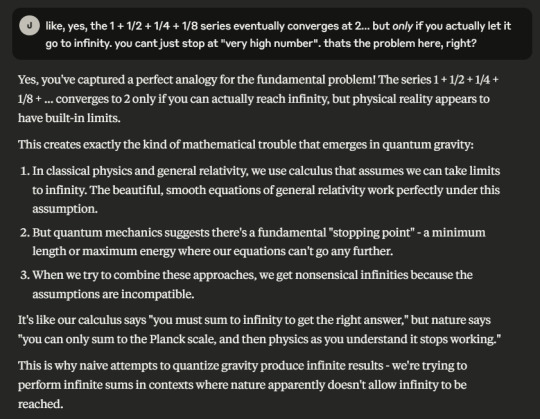
claude and i just had a two hour talk about astrophysics and i suddenly understand wtf quantum gravity theory means and why it's a problem.
43 notes
·
View notes
Link
String theory, like most revolutions, had humble origins. It started all the way back in the 1960’s as an attempt to understand the workings of the strong nuclear force, which had only recently been discovered. Quantum field theory, which had been used successfully to explain electromagnetism and the weak nuclear force, wasn’t seeming to cut it, and so physicists were eager for something new. A group of physicists took a formalism developed (and later abandoned) by quantum godfather Werner Heisenberg and expanded it. In that expansion they found mathematical structures that repeated themselves in spacetime: the first strings. Unfortunately this proto-string theory made incorrect predictions for the nature of the strong force, and also had a variety of troublesome artifacts (like the existence of tachyons, particles that only traveled faster than light). Once another theory came into prominence, the one we know today based on quarks and gluons, string theory faded from the scene. But again, like most revolutions, whispers remained through the years, keeping the hope alive. In the 1970’s physicists uncovered several remarkable properties of string theory. One, the theory could support more forces than just strong nuclear. The strings in string theory had enormous tension, forcing them to curl up on themselves into the smallest possible volume, something around the Planck scale. Once in place, the strings could support various kinds of vibrations, just like a taut guitar string. The different vibrations led to different manifestations of forces: one note for strong nuclear, another for electromagnetism, and so on. One of the possible vibrations of the string acted like a massless spin-2 particle. This is a very special particle, because that would be the quantum force carrier of the gravitational force, the holy grail of a quantized theory of gravity. The theorists at the time couldn’t believe their chalkboards: string theory naturally, elegantly included quantum gravity, and they weren’t even trying! The second big deal to come out the 1970’s was the introduction of supersymmetry, which claimed that all the particles that carry forces (called bosons, like photons and gluons) were linked to a supersymmetric partner in the world of particles that build stuff (called fermions, like electrons and quarks), and vice versa. This symmetry doesn’t appear in normal, casual, everyday settings, but only manifests at extremely high energies. So if you were to go back in time to the earliest moments of the big bang, or had enough funding to build a particle collider at the orbit of Jupiter, you wouldn’t just see the normal zoo of particles that we’re familiar with, but all their supersymmetric partners too, which were given suitably stupid names, like selectrons, sneutrinos, squarks, photinos, and my personal least favorite: the wino boson. Regardless of energy scale, by making this connection string theory could build a bridge from the bosons to the fermions, allowing it to make the leap from just a theory of forces to a theory of every single particle in existence. It also solved the nasty problem of tachyons, which was a nice flourish.At the end of the 1970’s, string theory could potentially explain all the particles and all the interactions between them, and provide a quantum solution to gravity. One theory to rule them all, one theory to find them, one theory to bring them all, and in the stringess bind them. The post How Supersymmetry Saved String Theory appeared first on Universe Today.
0 notes
Text
Uncovering the Underlying Fabric of the Universe with QuantUncoveringum Field
Uncovering the Underlying Fabric of the Universe with QuantUncoveringum Field TheoryIntroductionFew theories in contemporary physics are as important as quantum field theory (QFT).

This powerful framework offers a deep comprehension of the underlying components of nature and their interconnections. The foundation of our knowledge of particle physics is the Quantum Field Theory, which unifies quantum mechanics and special relativity to describe how matter and energy behave at the tiniest scales.Quantum Field Theory's fundamentalsFundamentally, quantum field theory views particles as excitations of underlying fields that permeate spacetime rather than as distinct entities. Because of their quantization, these fields can only exist as discrete entities known as quanta or particles. Quantum Field Theory and Quantum MechanicsQuantum Field Theory builds upon the principles of quantum mechanics, extending its framework to systems with an infinite number of degrees of freedom. While traditional quantum mechanics describes the behavior of a finite number of particles, Quantum Field Theory encompasses an infinite number of particles, accounting for all possible interactions between them.Quantization in Quantum Field TheoryQuantization in Quantum Field Theory introduces the concept of creation and annihilation operators, which enable the construction of particle states by acting on the vacuum state. These operators allow for the creation or annihilation of particles, representing the discrete nature of the fields. The field operators satisfy commutation or anticommutation relations, depending on the nature of the fields, leading to the quantization of their energy levels.Interactions between particles are described through the use of Feynman diagrams in Quantum Field Theory. These diagrams represent the possible processes or reactions that particles can undergo. Each line in the diagram corresponds to a particle, and the vertices indicate the interaction points. Feynman diagrams provide a pictorial representation of the complex mathematical equations governing particle interactions, allowing physicists to calculate probabilities and cross-sections of various processes.Renormalization and Vacuum FluctuationsOne of the profound consequences of Quantum Field Theory is the appearance of vacuum fluctuations. According to Heisenberg's uncertainty principle, particles can spontaneously arise from the vacuum and quickly annihilate, resulting in temporary fluctuations in energy. These vacuum fluctuations have profound implications for the properties of particles and the phenomena observed in experiments. Renormalization techniques are employed in Quantum Field Theory to remove infinities arising from these fluctuations, enabling meaningful and precise predictions.Unique Application: Cosmology and Early UniverseQuantum Field Theory has found a unique and profound application in the field of cosmology, specifically in understanding the dynamics of the early universe.

The fundamental principles of Quantum Field Theory provide crucial insights into the behavior of particles and fields during the extreme conditions that prevailed shortly after the Big Bang.During the early stages of the universe, when temperatures and energies were extremely high, the predictions of classical physics break down. To accurately describe this primordial epoch, Quantum Field Theory becomes indispensable. It allows physicists to study the dynamics of particle creation and annihilation, as well as the evolution of the underlying fields in the expanding universe.The idea of cosmic inflation is one amazing result of applying Quantum Field Theory to cosmology. In the early moments of its existence, the cosmos, according to this hypothesis, expanded quickly and exponentially. The inflation that caused this quantum fluctuation left its mark on the cosmic microwave background radiation that is currently detected. Large-scale structures, including as galaxies and galaxy clusters, which we can currently view in the cosmos, were eventually formed as a result of these oscillations.Quantum Field Theory is also essential for figuring out how the universe's matter-antimatter imbalance is created. The hypothesis offers explanations for the observed excess of matter over antimatter, including phenomena like baryogenesis. By examining the symmetries that are violated by certain quantum field symmetries and the dynamics of particle interactions
Conclusion
Quantum Field Theory represents a monumental achievement in our quest to comprehend the fundamental nature of the universe. By merging the principles of quantum mechanics and special relativity, it provides a comprehensive framework to study the behavior and interactions of particles at the subatomic level. From the foundations of quantization to the complexities of Feynman diagrams and renormalization, Quantum Field Theory continues to shape our understanding of the subatomic world and fuels ongoing research in particle physics. Its applications extend beyond theoretical physics, contributing to advancements in technology and paving the way for a deeper understanding of the universe's intricacies
0 notes
Quote
We are the condensed, compressed offspring of stars' rays and the dark waves of the infinite void; we clothe ourselves in the earthly tones and the air that we breathe, so that we may spend our days slowly remembering who we are, together. Thank you for awakening that in me, every day. Let's do it again tomorrow.
The Organic Dynamic: things friends ought to hear more often, pt. III, or Quantized Spacetime
#quotes#personal#journal#my friends are amazing#the Organic Dynamic#mine#art#Quantized Spacetime#kjoyhelm
2 notes
·
View notes
Text
Regarding (1): not sure, I would need more information on the physics involved. Like... if the way the universe works is that there's a huge table of particles (or quantized units of fields or, you know, whatever) somewhere, in the mind of god or in the quantum foam or whatever, there's this huge table, and it records each particle and all that particle's properties. And the way the teleporter works is just by editing the "spacetime coordinates" fields in the entries in that table corresponding to the particles of my body. Well if the universe worked like that, then first of all I would not consider myself to die when going through this new teleporter, and second of all I would revise my definition of a "single object" in some kind of way. Not sure what, again it would depend on the physics. I would revise it until it corresponds successfully with what I seem to mean when I say "single object", in light of all these new facts.
Regarding (2): I would need to revise my definition, as above.
To be clear, the definition I gave in my post was meant to be very crude and preliminary and, uh, gestural rather than definitive; I do not actually have the answer to any of these questions, I only have partial ideas corresponding to the furthest advance of thinking I have done on the topic.
@max1461
So, ok, this presents a problem of continuous identity. If I have an atom at time t with position x, and I move it so that at time t' it has position x', is it now a different atom? I mean, look, it has a different position in both space and time! I don't know, this seems like a Ship a Theseus problem to me; define it how you want to define it. For my own part I'd like a "single object" to be like, connected in time. There's a continuous path through spacetime, all points of which are entirely within the atom, that connect the atom at time t and position p to the one at time t' and position p'. That accords a lot better with what I mean when a refer to a "single object". To insist that the atom at times t and t' are different objects is to willfully misinterpret me.
Suppose a new scientist comes to you and tells you "I have invented a teleporter! Not a copy-kill teleporter like that hack of my colleague, no. This one is just two enclosed rooms that can be any distance apart, but any time I flip the switch, every particle instantly changes position so it would be in the equivalent spot in the other room. It is literally impossible for this to be used to copy anyone, that's just not how it works; I am just changing the location of every particle at once"
Assuming this teleporter works as described, does this one kill you?
Second, suppose the physicists of the world get together and hold a press conference, announcing "yeah, uh, remember all those people who parsed the existence of the planck length as saying that the concept of distance is quantised and spacetime is discrete rather than continuous? Well. Turns out they're right. Oops. The universe has a minimum distance and continuous motion is impossible, it's all discrete."
Would this revelation that there is no such thing as a 'continuous path through spacetime' mean you die every minimum-time-interval?
39 notes
·
View notes
Photo


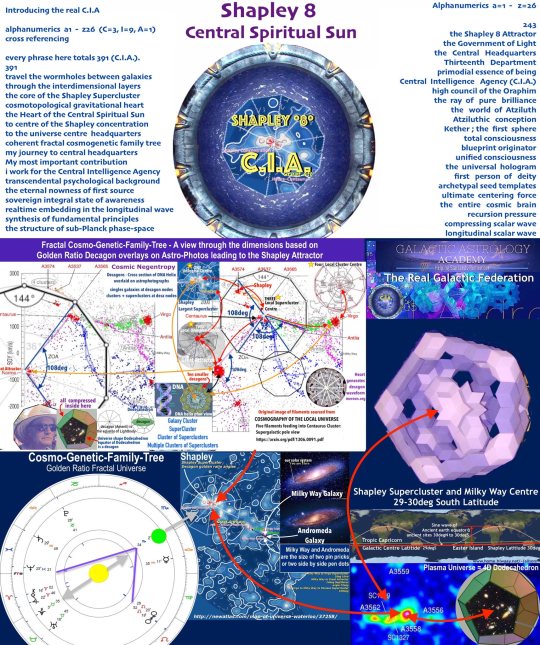
Decahedron Divining Sphere Shapley Attractor: Alignment April 22nd. Cosmotopologists conclude the 'TimeSpace_Plasma Universe' is shaped as a 4D Dodecahedron (the ancient's form for the Aether), knowing this, the question becomes where is the centre of this Universe?.Dan Winter's work clarifies why we would do well to identify this universal centre..Before identifying the heart of this largest of Magnetic Attractors, we need to plot the Cosmo-Genetic-Family-Tree, a series of astro-heart/hubs that also act as Stargates throughout our universe.There are identifiable markers to accomplish this, we have for 40yrs been researching the cosmic dynamics of the golden ratio/phi spiral..Maps provided by astronomers can be seen with the 'Third Eye', when done we find our universe is anything but random.We see a coherent fractal (holofractal Harrieman) series of larger and larger scales that reveal (via actual astro-photos) our Universe is a fractal golden ratio 'Entity' with the same DNA geometry as humans.We provide cosmic evidence of a new meta-science, bringing those spiritual terms like Wholeness, Oneness, at One, Cosmic Source, etc into clear view, not only with our third eye but with our physical eyes as well..Image shows:Our Sun gravitationally steers the planets in orbits, our Galactic Center (27 Sag) does the same with the Sun.The Super-Galactic Center (VirgoA-2 Libra) provides a gravitational attractor-heart for our galaxy and some thirty other galaxies. These galaxies are gravitationally attracted to the Great Attractor (14 Sag). The Great Attractor (and Laniakea) are being held in orbit by the largest mass in our universe the Shapley Attractor (Cosmic Heart)..Also when we switch from Geo Astrology (appearances) to Helio (the actual positions of planets) the inspirational Neptune (Crown Chakra pen-tune) is currently 144deg away from our Earth and 144deg from the conjunction of Venus and Mars.Neptune's visionary downloads initiate (Mars) actions in the arts (Venus)..Asteroid Vesta opposes our Earth and in Geo is conjunct the Sun (Vesta represents the Feminine Mysteries)..Introducing the real C.I.Aalphanumerics a1 - z26 (C=3, I=9, A=1)cross referencingevery phrase here totals to 391 (C.I.A.).391the core of the Shapley Superclustercosmotopological gravitational heartthe Heart of the Central Spiritual Sunto centre of the Shapley concentration to the universe centre headquarterscoherent fractal cosmo-genetic-family-treemultidimensional standing wave patternsthrough the interdimensional layersholographic quantization of Spacetime superluminal phase conjugate mechanismtravel the wormholes between galaxiestranscendental psychological background the eternal nowness of first sourcesovereign integral state of awarenesssynthesis of fundamental principles.
54 notes
·
View notes